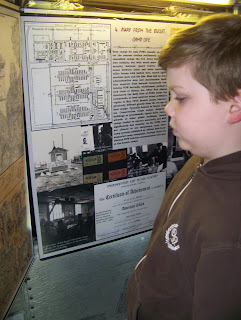The Richland library hosted a traveling bus-eum teaching on the German POW's that were held here from 1943-1946. My cousin is a huge history buff and wrote me an email to invite the boys down to see it.
In Mississippi alone there were four main POW camps. Below is a picture of the map which was posted in the front of the bus. The squares designate the main base camps and the circles designate the branch camps. The main camps were in Hattiesburg (at what is now Camp Shelby), Clinton, McCain and Como. There were more than 20,000 Germans held here in Mississippi.
I am not sure what you think of when you think of a POW camp, but you should erase all those thoughts. Mississippians have a reputations for southern hospitality and they extended this to these POW's despite the fact that they were our "enemy". Families around town would hire the POW's to help out on their local farms. Their own sons had gone off to war and they desperately needed help with their farms. Families became attached to these young men who were as homesick for their families as these families were lonely for their sons. POWs were invited to homes for Thanksgiving and Christmas dinners.
If the men were willing to work they were paid 80 cents to put into their kanteen. POWs would use this money to buy cokes and even slip into town to watch an occasional movie and then slip back into their camps.
POWs organized bands, soccer teams, orchestras, theater groups and art circles. Many beautiful gifts were given to members of the families that they became attached to while here.
I loved this postcard which was drawn showing "Silent Night"
Camp Clinton is particularly significant compared to other POW camps in the country. First, the camp's prisoners provided the work during the initial, and more tedious, phases of construction of the Mississippi River Basin Model. Their work, which is valued at several million dollars, allowed the U.S. Army Corps of Engineers to complete their flood control project. In the decades after the Basin Model's completion, data collected during tests helped to save billions of dollars in property damage. Second, a special compound constructed at Camp Clinton was where all but a few of the Germany generals held in the United States were confined. Out of nearly forty generals in American captivity, thirty-five (and one admiral) were at one time or another at Camp Clinton. There was no other facility for German generals.
Members of the Clinton POW camp still have a reunion in Germany. They call themselves the Clinton family.
These POW camps were created shortly after the Geneva Convention was signed and they certainly honored the very spirit and hopes of that Convention.







1 comment:
That's so cool! I knew that there were a couple here during the war, but didn't realize there were that many, or all of that about them. Thanks for sharing :)
Post a Comment